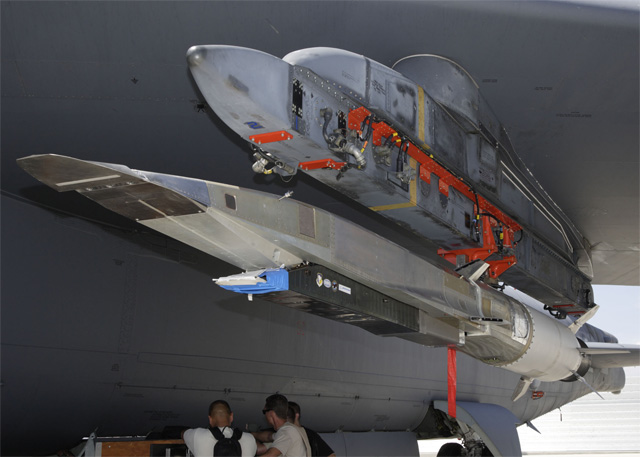It has been a mixed bag on the cutting edge for Boeing this month.
An Aug. 7 maiden flight was celebrated by the aerospace giant, which teamed with NASA to produce the X-48C, an experimental blended wing body design that could significantly reduce the noise of future airlines. A week later, another Boeing design, this one aiming to speed past Mach 6, failed in testing.

The scramjet-powered X-51 was launched from a B-52 on Aug. 14, but lost control before the engine was fired, according to an unnamed source. U.S. Air Force photo/Chad Bellay.
The X-51A Waverider, an Air Force experiment so named because it is designed to ride its own shockwave at hypersonic speed, crashed into the Pacific Ocean after a control fin failed seconds after the X-51A separated from the rocket booster, according to an Air Force statement.
The sleek missile was designed to be dropped from a B-52 at altitude, and was supposed to demonstrate hypersonic technology—sustained speed above Mach 5, a challenge that has bedeviled generations of engineers. Many such efforts have never even made it off the drawing board, such as the X-30. Once dubbed the “new Orient Express” by President Ronald Reagan and envisioned to carry passengers from Washington to Tokyo in two hours, the X-30 was canceled in 1993 due to budget concerns, and disbelief that technical challenges could be overcome. It never flew.
The X-51A has now managed sustained flight just once in three attempts. The first flight in 2010 fell short on speed—Mach 4.88—but set a record for sustained flight under the power of an air-breathing scramjet at 143 seconds. (A scramjet compresses supersonic airflow with a Venturi tube, and without a turbine or related moving parts; a ramjet is basically a scramjet designed to operate at subsonic speeds.)
The two subsequent flights (three, if you count an attempt that aborted when the X-51A failed to detach from the B-52) fell well short of that.

A scale model of a future airliner designed by Boeing’s Phantom Works, the X-48C flew for the first time Aug. 7 in California.
In June 2011, the Pratt & Whitney Rocketdyne SJX61 dual-mode ramjet/scramjet engine failed to transition during flight from ethylene fuel used for engine start to the JP-7 fuel used for sustained flight, and wound up clocking just under 10 seconds around Mach 5 before taking its first and final swim.
The Aug. 14 failure of the third X-51A built also ended with a splash: None are designed for post-flight recovery, all wind up in the ocean—one way or another. Boeing is close to completing a fourth X-51A, though Aviation Week reports there is no funding allocated yet for the fourth to fly.
In contrast, the X-48C was celebrated by Boeing and NASA, which is backing a variety of futuristic aircraft designs—not including the X-51A, which is an Air Force effort.
The X-48C is a remote-control scale model (500 pounds with a 21-foot wingspan, 8.5 percent of the future version’s full size) flown out of NASA’s Dryden Flight Research Center on the grounds of Edwards Air Force Base. The X-48C climbed to 5,500 feet during a 9-minute maiden flight.
Boeing blended wing body designs have been tested since 2007, with the latest version powered by a pair of turbojets producing 89 pounds of thrust each and replacing a trio of 50-pound thrust engines used on the previous model. Boeing and NASA believe the blended wing body offers promise to deliver high-efficiency, heavy lift capability with significant noise reduction. The X-48C engines are mounted above the fuselage to help reduce its noise signature, and this version is specifically designed to test the effect of noise reduction modifications on low-speed control abilities previously demonstrated.



